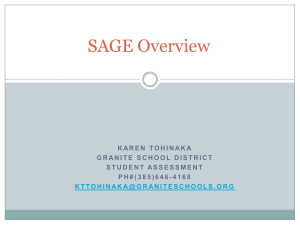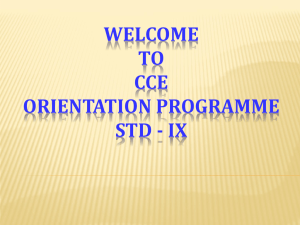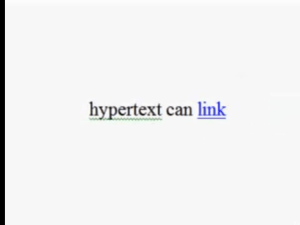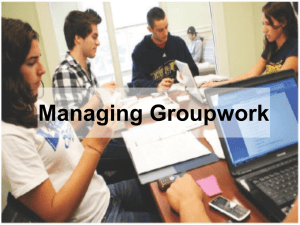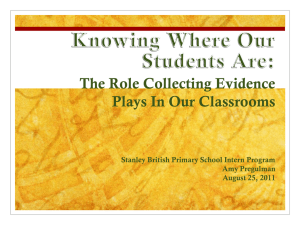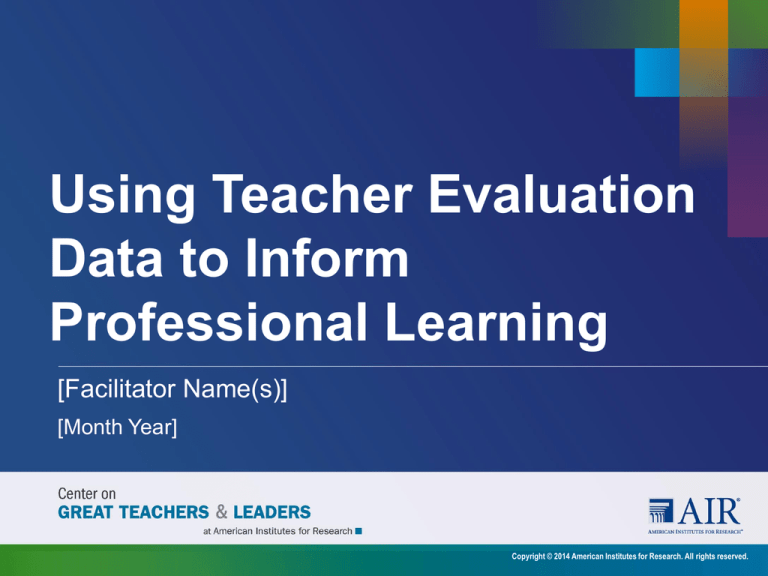
Using Teacher Evaluation
Data to Inform
Professional Learning
[Facilitator Name(s)]
[Month Year]
Copyright © 2014 American Institutes for Research. All rights reserved.
Welcome, Introductions, and
Agenda
2
Welcome!
3
Mission of the Center on
Great Teachers and Leaders
The mission of the Center on Great Teachers
and Leaders (GTL Center) is to foster the
capacity of vibrant networks of practitioners,
researchers, innovators, and experts to build
and sustain a seamless system of support for
great teachers and leaders for every school in
every state in the nation.
4
Comprehensive Centers Program
2012–2017 Award Cycle
5
Agenda
Module Purpose and Overview
Definitions and Assumptions
Using Evaluation Data for Self-Reflection and
Goal Setting
Using Evaluation Data for Formative Feedback
Using Summative Evaluation Data for Individual and
Schoolwide Planning
Understanding Systemic Supports for Effective Use of
Evaluation Data to Inform Professional Learning
Wrap-Up
6
Module Purpose and Overview
7
Module Overview
Goals:
• Explain how teacher evaluation data informs
professional learning.
• Practice analyzing teacher evaluation data to inform professional
learning.
• Discuss the challenges and opportunities for using evaluation data
to inform professional learning.
8
National Picture
Professional Growth in Educator Evaluations: Defined by Regulations
= Professional Growth or Learning
= Improvement Only
9
National Picture: A Different View
Professional Growth in Educator Evaluations: Defined by State Guidance or
Elementary and Secondary Education Act Waiver Applications
= Professional Growth or Learning
= Improvement Only
10
Definitions and Assumptions
11
Activity 1: Human Continuum
One side of the room is designated “Strongly Agree,”
and the other side of the room is designed
“Strongly Disagree.”
As the statement is read, determine where your district
falls on the continuum. Vote with your feet.
Turn to someone next to you. Share your rationale for why
you chose this place on the continuum.
12
Activity 2: Table Warm-Up
As a group, brainstorm a
list of types of professional
learning (activities,
designs, venues, modes of
delivery) currently used in
your state.
Write these types on the
chart paper provided.
13
What Is Effective
Professional Learning?
Focused
Active
Collaborative
Ongoing, Embedded, and Differentiated
Adapted from High-Quality Professional Development for All Teachers: Effectively Allocating Resources
(http://www.gtlcenter.org/sites/default/files/docs/HighQualityProfessionalDevelopment.pdf)
14
Activity 3: Table Warm-Up Revisited
Using the generated list of professional learning activities,
identify whether the activities are one of the following:
• Focused (on content and on teaching the content)
• Active
• Collaborative
Bonus: Draw a circle around activities that are
differentiated; underline any activity that is ongoing
throughout the year; and star (*) any activity that is
job embedded.
15
Shared Definitions:
Evaluation Data Use Cycle
SelfReflection and
Goal Setting
Summative
Evaluation
Formative
Evaluation
16
Shared Definitions: Evaluation Data
Evaluation data provide evidence of individual teacher
practice and performance collected throughout the
evaluation cycle.
Characteristics of evaluation data are as follows:
• May be quantitative (numbers) or qualitative (narrative statements).
• May include inputs (teacher actions and behaviors) and outcomes
(student learning).
• Can be aggregated to the school, district, and state levels for
further analysis.
17
Shared Definitions: Evaluation Data
Data Sources
Evidence/Data Element
Examples
Summary Data
Rubric-based
observations of
practice
Percentage of students on task
Number of higher order questions
Narrative descriptions, running
records
Practice ratings
Artifacts
Professionalism/
practice ratings
Assessments of
student learning
Student work portfolio
Standardized tests
Student performance
assessments
Student learning
objectives
Value-added
measure scores
Student/parent
perception surveys
Mean standard scores
Perception scores
Unit plans
Classroom newsletter
Student behavior plan
Team action-planning protocol
18
How Evaluation Data
Inform Learning
Teacher
Evaluation Data
Self-Reflection
Professional
Learning
Teacher
Evaluation Data
Formative Feedback
Professional
Learning
Strategic Planning
Professional
Learning
Teacher
Evaluation Data
19
Using Evaluation Data
for Self-Reflection and
Goal Setting
20
Teacher Self-Reflection and
Goal Setting
In this step of the evaluation data use cycle, teachers take
charge of their own growth in the following ways:
• Analyzing the impact of their practice on student learning
• Engaging in reflection on their practice
• Setting focused professional and student learning goals, with
concrete steps to get there
• Actively collaborating with colleagues to problem-solve
• Adjusting their plans as a result of this reflection
21
Activity 4: Strategic Use of Data
What teacher evaluation data will be most helpful to a
teacher when engaging in self-reflection and goal setting?
• Review the list of data gathered during the teacher evaluation cycle.
• What teacher evaluation data are most valuable for self-reflection and
needs assessment purposes?
• What data are least useful?
Use Handout 1 to record your thoughts.
Teacher
Evaluation Data
Self-Reflection
Professional
Learning
22
Activity 5: Strengthening a
Self-Assessment
Read Handout 2.
In table groups, discuss Mr. Green’s self-assessment and
reflection.
Identify the data that Mr. Green used to reflect on his
practice and his students’ performance.
• Which data are the least informative?
• Which data would you suggest he use instead to dig deeper?
Brainstorm professional learning supports for each of the
focus areas that Mr. Green identified.
23
Essential Conditions for Effective
Self-Reflection and Goal Setting
Structural?
Cultural?
Technical?
Fiscal?
24
Using Evaluation Data for
Formative Feedback
25
Formative Evaluation
Goals:
• Provide authentic, specific, and evidence-based feedback on practice.
• Encourage teacher self-reflection on practice.
• Identify professional learning opportunities.
Activities:
• Collaborative conversation(s) between the teacher and evaluator
to share evidence, ask questions, and provide feedback
• Adjustment to goals and plans
• Connection to resources and supports
26
Using Data for Formative Feedback
Formative data are gathered and shared throughout the
evaluation cycle.
To inform professional learning, data should:
• “Diagnose” strengths and areas for instructional improvement.
• Be presented as evidence statements rather than judgment or analysis.
• Focus on actions and behaviors the teacher can influence.
Teacher
Evaluation Data
Formative Feedback
Professional
Learning
27
Translating Data Into Feedback
Evaluators can translate evidence about teacher practice
into actionable feedback to teachers.
Such feedback, when delivered effectively, will result in
productive conversations and greater likelihood that
professional learning will occur.
28
Activity 6: High-Quality Feedback
Look at Handout 3.
Listen to the description of each characteristic of
high-quality feedback.
For each characteristic, write down some key points
on the handout.
29
Characteristics of
High-Quality Feedback
Teachers learn best when
feedback is:
•
•
•
•
Tied to specific teaching standards.
Specific, detailed, and evidence based.
Timely and frequent.
Constructive, with effective use of
questioning.
30
Activity 7: High-Quality
Feedback Revisited
Look at Handout 3 again.
Watch the video in the following slide.
Use Handout 3 to jot down things you see or hear in the
video that align with the high-quality feedback practices.
31
Using Evaluation Data:
Example of a Feedback Conversation
Observing Instruction to Build Capacity
Waterford High School, California
Carolyn Viss, chair of the mathematics
department at Waterford High School,
conducts a coaching session based on
classroom observation of a core algebra
class. She acknowledges good instructional
practices and offers solutions for specific
dilemmas. (5:18 minutes)
Discussion: To what extent did this
feedback session promote learning?
What data or evidence did Ms. Viss
refer to in her questions?
Video courtesy of the U.S. Department of Education’s former
Doing What Works initiative.
Download video at:
https://vimeo.com/84709443.
The password is DWWVideo.
32
Essential Conditions for Effective
Formative Feedback
Structural?
Cultural?
Technical?
Fiscal?
33
Using Summative Evaluation
Data for Individual and
Schoolwide Planning
34
Summative Evaluation
Goals:
• Summarize evaluation data for individual teachers.
• Identify patterns in teacher and student performance across the school to
inform the allocation of resources.
• Identify professional learning and career opportunities.
Activities:
• Analysis of individual teacher evaluation data to determine final rating(s)
• Conversations between the teacher and evaluator about performance
trends and patterns
• Connection of resources, supports, and opportunities for the next
evaluation cycle
35
Activity 8: Using Data to Plan for
Differentiated Professional Learning
Read Handout 4, focusing on the scenario with
Ms. Blue and her summative evaluation plan.
Answer the guiding questions in Handout 4.
Outline a professional learning plan for Ms. Blue on your
chart paper.
Include the following elements in your plan:
• Professional learning goals
• Professional learning activities
• Success metrics
36
Activity 9: Using Data to Plan for
Schoolwide Professional Learning
Read Handout 5.
As a table group, read the
summary ratings data for teachers
at Orange School.
Discuss and share:
• What patterns do you see in the data?
• What are Orange School’s greatest areas
of need?
• Based on these data, what professional
learning activities would you include in a
schoolwide professional learning plan?
37
What Should You Do When the Data
Are Mixed? (Choose the best answer.)
A. Collect more data.
B. Consider the (data) source.
C. Dig deeper into the data—what aspect of performance is
really reflected in the numbers?
D. Provide professional learning to address identified areas
for improvement even if some of the data indicate that
the teacher does not need it.
E. All of the above
F. Other
38
Using Summative Data
What summative data are typically collected?
Which of these data are easiest to measure or aggregate?
Which data provide the most insight into teaching and
learning?
Teacher
Evaluation Data
Strategic Planning
Professional
Learning
39
Principles of Effective Planning
Using Evaluation Data
Teacher evaluation data help ensure better allocation of
resources, including teacher time.
Human judgment is an inevitable—and critical—
piece.
To fill in the gaps around the data, those closest to
the work of teaching and learning should be included in
the planning.
Necessary conditions for teacher learning must exist.
Professional learning is high stakes!
40
Essential Conditions for Effective Data Use
for Planning/Assessing Professional Learning
Structural?
Cultural?
Technical?
Fiscal?
41
Understanding Systemic
Supports for Effective Use of
Evaluation Data to Inform
Professional Learning
42
Activity 10: Promising Examples of
Using Data for Teacher Learning
Read Handout 6.
How do the four examples of promising practices align with
the conditions for professional learning identified earlier?
What more would you like to know?
Which example is worth studying further and potentially
applying in your context?
Group vote!
43
Activity 11: Pause for Self-Assessment:
Supporting High-Quality Learning
As a school or district team,
respond to the questions in
Handout 7: District SelfAssessment Tool.
From High-Quality Professional Development for All
Teachers: Effectively Allocating Resources
(http://www.gtlcenter.org/sites/default/files/docs/High
QualityProfessionalDevelopment.pdf)
44
Reflection and Wrap-Up
45
Closing the Loop
Focused
Active
Collaborative
Ongoing, Embedded, and Differentiated
46
Linking Educator Evaluation and
Professional Learning
It’s Not Just About …
It’s Really About ...
Including student data in
the evaluation system
Analyzing the results in relation to
specific teaching and leadership
practices
Conducting frequent,
reliable observations
Meaningful, actionable feedback and
conversations about how to grow
Rating teachers with
a summative rating label
Linking evaluation results to career
paths, opportunities, and systems of
support
47
Additional Resources
What
Resource Topic or Title
Where It’s Available
SelfAssessment
Teacher Evaluation Self-Assessment
Information and Process
http://www.doe.mass.edu/edeval/training/modules/
M3.pdf
Formative
Evaluation
Carnegie Foundation: Feedback
Conversation Protocol
http://commons.carnegiefoundation.org/wpcontent/uploads/2013/08/BRIEF_Feedback-forTeachers.pdf
Formative
Evaluation
Institute of Education Sciences:
Structuring Data-Informed Conversations
http://ies.ed.gov/ncee/edlabs/regions/pacific/pdf/
REL_2013001.pdf
Summative
Evaluation
Observation Data Collection Tool
http://bloomboard.com/schools
Publication
Generating Teaching Effectiveness: The
Role of Job-Embedded Professional
Development in Teacher Evaluation
http://www.gtlcenter.org/sites/default/files/docs/
GeneratingTeachingEffectiveness.pdf
Publication
High-Quality Professional Development
for All Teachers: Effectively Allocating
Resources
http://www.gtlcenter.org/sites/default/files/docs/
HighQualityProfessionalDevelopment.pdf
Publication
Linking Teacher Evaluation to
Professional Development: Focusing on
Improving Teaching and Learning
http://www.gtlcenter.org/sites/default/files/docs/
LinkingTeacherEval.pdf
48
More questions?
Contact the GTL Center!
1000 Thomas Jefferson Street NW
Washington, DC 20007-3835
877-322-8700
gtlcenter@air.org
www.gtlcenter.org | www.air.org
www.facebook.com/gtlcenter
www.twitter.com/gtlcenter
Advancing state efforts to grow, respect, and retain great teachers
and leaders for all students
49


